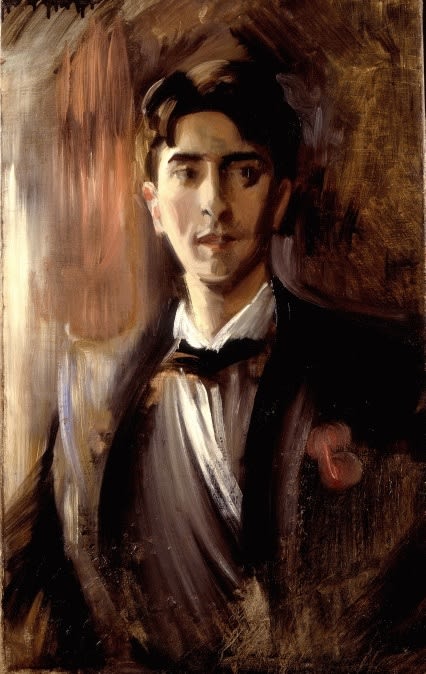
Federico de Madrazo
To view all current artworks for sale visit philipmould.com
This portrait of Cocteau, which had belonged to him and had hung in his flat at 10 Rue d'Anjou in Paris is a superb expression of his elusive, flickering genius, which expressed itself in every artistic medium in six decades of the twentieth century. Cocteau not only impressed fellow artists of the calibre of Pablo Picasso and Sergei Diagilev, but in many cases, as with Madrazo, made collaborators of them too. At the date of this portrait, probably painted c.1910 – 12, Cocteau and Madrazo were working on a ballet in one act called Le Dieu Bleu, which they wrote together for Diagilev. Madrazo’s cousin, the composer Raynaldo Hahn supplied the music for the production.
The enterprise was typical of the extravagant and avant-garde statements by which Cocteau made his mark on Parisian intellectual society in the years leading up to the First World War. His precocity knew no bounds, and at the age of sixteen he had caused a sensation by arriving for his mother’s birthday party as Heliogabalus carried on a litter borne by negro attendants. This baroque extravaganza set the tone for Cocteau’s life, which was marked by a relentless creative variety, experiment and the blurring of the boundary between his art and his life. His career as a poet was launched in 1909 when his first volume of work was published under the title, La Lampe d'Aladin. Best known for his novel Les Enfants Terrible, and the play La Machine Infernale, Cocteau mixed with a wide circle of fellow artists and writers including not only Picasso, but Apollinaire and Modigliani. After recovering from an opium addiction in the late 1920's, he became involved in filmmaking, producing his first work, Blood of a Poet in 1930. He sought sensational exploits throughout his career, and his eighty-day trip round the world made in emulation of Jules Verne’s fictional hero – published in 1936 as Ma Premiere Voyage – and provoked by a bet exemplifies his recognition that the artist’s life is his art.
Madrazo was a member of the famous Spanish artistic dynasty that included José de Madrazo y Agudo who had studied under Jacques-Louis David, and Federico de Madrazo y Küntz who dominated the art establishment in Spain during the last decades of the nineteenth century. Federico de Madrazo y de Ochoa was inspired less by the staid manner of Federico de Madrazo y Küntz than by the sinuous elegance of Giovanni Boldini, although the way in which his diaphanous sitters almost dissolve into their background is his own. Most of his work remains in the ownership of the families who commissioned him, but Laure de Sade, Comtesse Adhéaume de Chevigné (Metropolitan Museum of Art,. New York) is a superb example of his sophisticated and elegant portraiture, and directly compatible with the present painting.
Provenance
Jean Cocteau;La Comtesse de Forceville, Paris;
The artist's cousin
Exhibitions
''Diaghilev Exhibition'', Edinburgh Festival, Edinburgh, 1954;''Diaghilev Exhibition'', Forbes House, Londo,n 1954-55;
''Proust and his Time'', Wildenstein and Co., London, 1955;
''Jean Cocteau et ses Temps''
Literature
R. Buckle, In Search of Diaghilev, London, 1955, p. 86, no. 104, illus.;P. Quennell, ed. Marcel Proust, 1971, p. 201, illus.;
Everyman Publishers, Oscar Wilde, A Picture of Dorian Gray, 1991, illus. on front cover.
Be the first to hear about our available artworks
* denotes required fields
We will process the personal data you have supplied in accordance with our privacy policy (available on request). You can unsubscribe or change your preferences at any time by clicking the link in our emails.